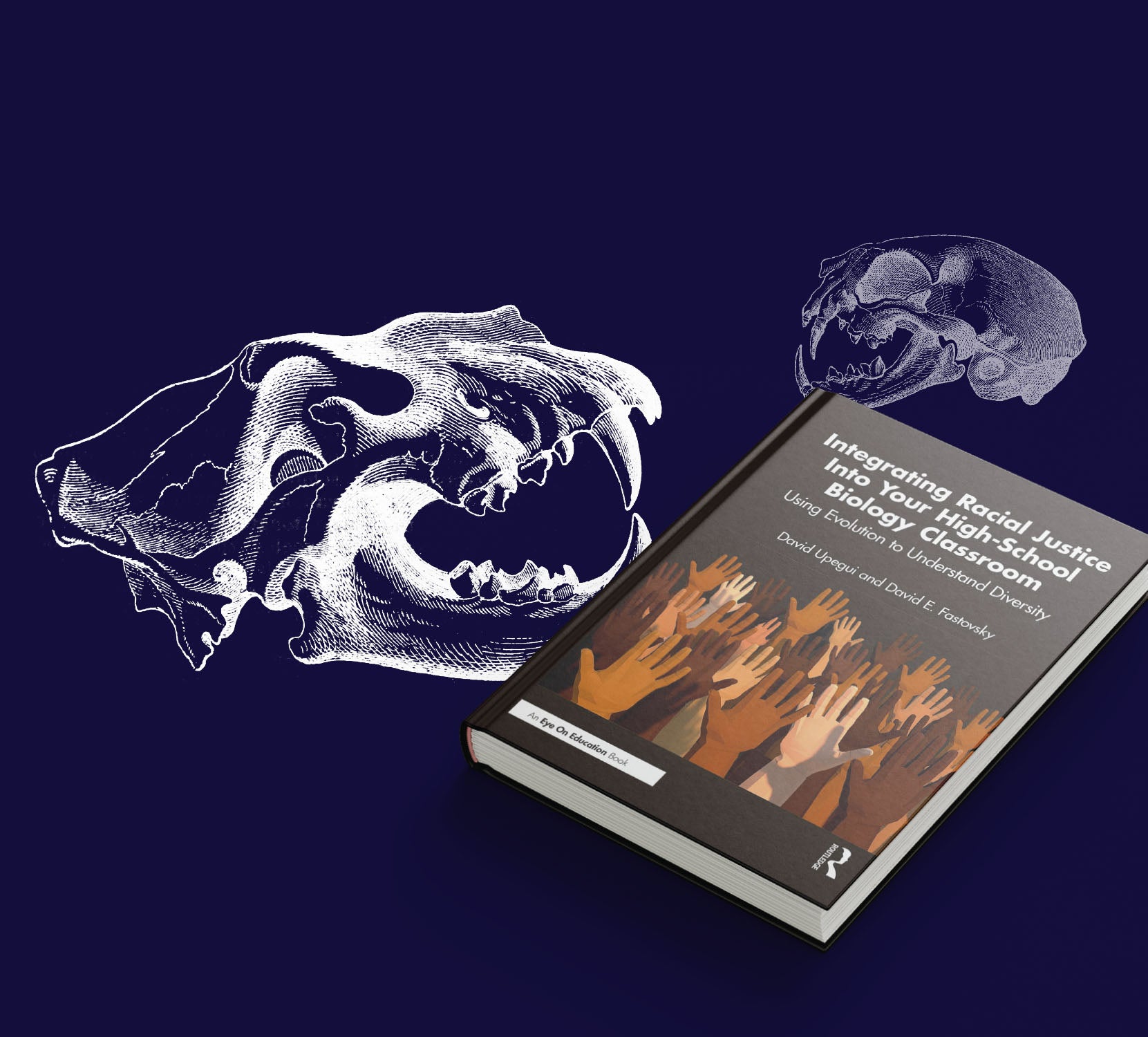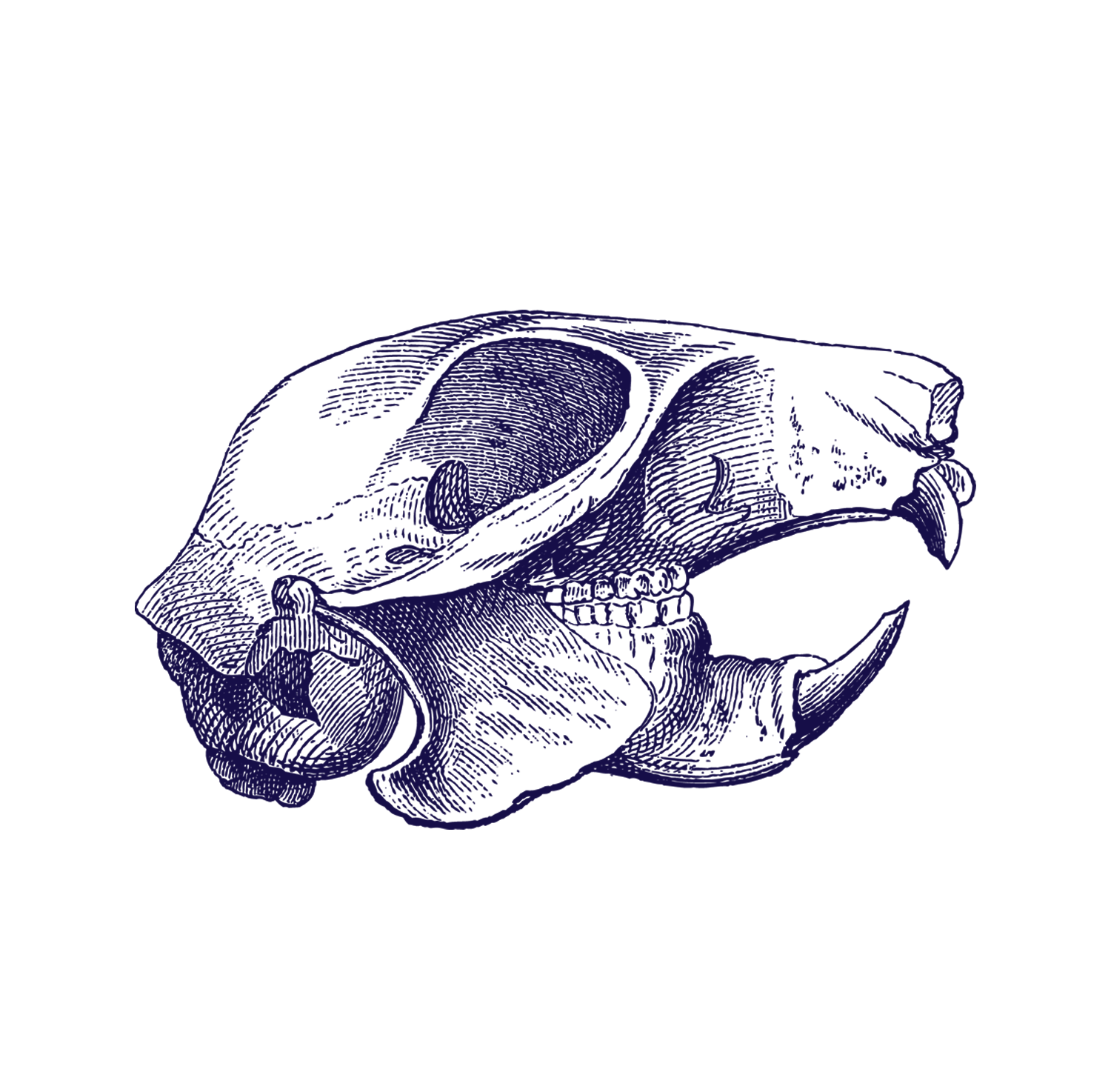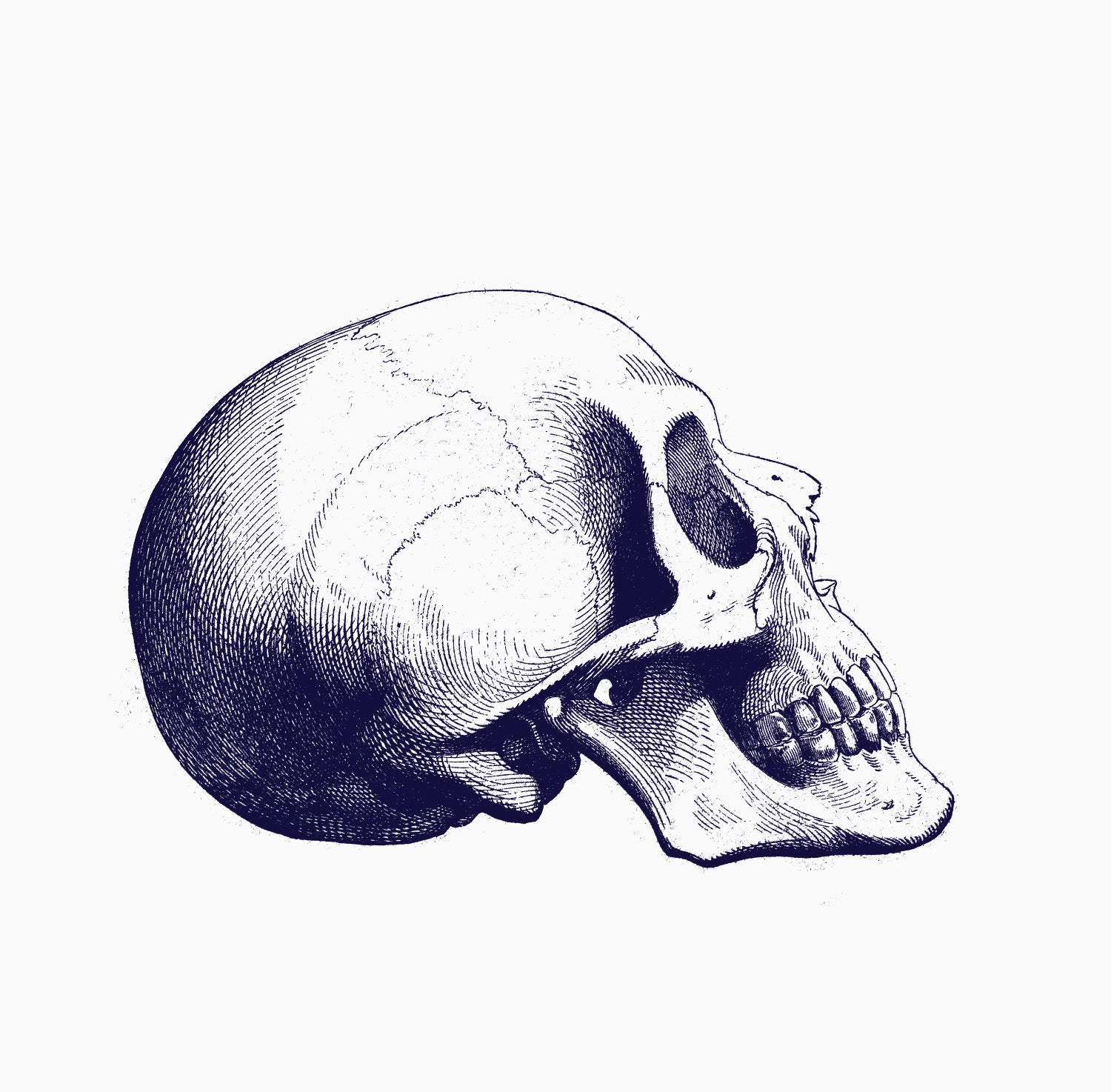
What Does Social Justice Have to Do with Evolution?
Everything.
Integrating Racial Justice Into Your High-School Biology Classroom: Using Evolution to Understand Diversity
David Upegui and David E. Fastovsky (2023)
Designed as a practical manual for teaching concepts of equity through evolutionary biology, the book offers context on the historical relationship between science and racism and includes lesson plans and classroom exercises.
Award-winning Central Falls High School biology teacher David Upegui, Ph.D. ’21, teamed up with URI paleontologist David Fastovsky to write a book aimed at helping teachers incorporate social justice into the biology curriculum.
By Dawn Bergantino ’94
David Upegui, Ph.D. ’21, was conducting public health research at Brown University with plans to pursue his Ph.D. in epidemiology. When his son was born with Down syndrome in 2004, his plans changed. The son of a teacher, Upegui grew up valuing academic achievement but began to shift focus from his own development to that of his son. He began taking courses in education to help ensure he provided his son with the best set of opportunities he could.
In 2010, then-U.S. Secretary of Education Arne Duncan’s efforts to remake failing schools resulted in the wide-scale firing of teachers in school districts across the country, including Upegui’s alma mater, Central Falls High School, which made national news when it fired all of its teachers. That’s when Upegui felt a calling. He took a significant pay cut and put his plans to get a Ph.D. on hold to return to Central Falls as a high school biology teacher.
Upegui explains his decision, quoting Gandhi: “One has to speak out and stand up for one’s convictions. Inaction at a time of conflagration is inexcusable.”
And the now-award-winning teacher has done just that. Just a little over a decade later, Upegui has not only earned a Ph.D., fulfilling a promise he made to himself and his first mentor at Brown not to let this mission-driven adventure derail his own education, but he has also coauthored a book—his first academic one—that could very well change the way we think about and teach high school biology.
The book, Integrating Racial Justice Into Your High-School Biology Classroom: Using Evolution to Understand Diversity, details how, at points in history, science has been used to reinforce racism. The book provides a blueprint for integrating the study of racial justice with evolutionary biology in the high school biology curriculum. And, importantly, it is also a model for using rigorous science education to help liberate and personally empower students.
Central Falls High School (CFHS)
made national news when it fired all
of its teachers. David Upegui felt a
calling and changed his career path
to teach biology at CFHS.
David Upegui (left) and David Fastovsky in Upegui’s Central Falls High School classroom. They wrote and received a grant to purchase the skulls.
“To understand why this is so powerful, you really have to know who David Upegui is and what he has done,” says Upegui’s coauthor David Fastovsky, a URI professor emeritus. He is “a Latino whose mother kept her family alive by cleaning hotels, but who ultimately found his calling and became as good at what he does—teaching science—as the very best in America.”
The son of immigrants, Upegui moved to the United States from Colombia when he was 10. While he had taught intermittently at the college level, the thought of leaving Brown to teach high school was unnerving. He was encouraged by his mentor, the late Professor Tom Lasater from Brown University, to follow this path to which he was so strongly drawn. But they agreed he had a responsibility to himself, his family, and his community to earn his Ph.D.—even if it was not in epidemiology.
In the fall of 2010, Upegui began teaching high school science at Central Falls High School. While the large classes and lack of resources typical of an urban school district were challenging, he found no lack of talent or eagerness among his students. Early in his teaching career, he helped one of his students successfully apply to Brown University’s Program in Liberal Medical Education, an eight-year combined bachelor’s-M.D. program. The excitement surrounding the young man’s acceptance into the program buoyed the entire community.
There were acceptances to other highly respected colleges and universities. Yet, at the same time, there were students who felt discouraged from pursuing their ambitions, believing themselves inherently unable to achieve.
While working to dispel this belief among his high school students, Upegui found himself teaching a URI course on evolutionary theory for practicing teachers. That’s how he met Fastovsky, a renowned paleontologist and professor of geosciences in URI’s College of the Environment and Life Sciences. After putting Upegui through his paces to assess his knowledge of evolutionary theory, Fastovsky struck up a conversation with Upegui about how science should be taught.
That led to more conversations and eventually—at Fastovsky’s urging—they wrote a successful grant proposal to the Paleontological Society that would enable Upegui to acquire animal skulls for his Central Falls students to study.
Upegui recalls that Fastovsky asked him, “What’s one thing—as a high school teacher—you’ve always wanted to do, but couldn’t?”
And Upegui had an answer. “One of the things I’ve always wanted to do is have my students work with actual animal skulls and figure out, based on the morphology, how they evolved and what the connections are between different animals.”
“So, we wrote the grant. And we got the grant. And we got the skulls. And I thought to myself, ‘Yeah, I mean, the skulls are just the beginning, but I need you,’” Upegui says, referring to Fastovsky, who was integral to that first success.
David Upegui (left) with his major professor, David Fastovsky, at Upegui’s graduation. He received his doctoral degree in education from URI in 2021.
From there, Fastovsky began visiting Upegui’s high school classroom. Upegui says, “He is truly a brilliant human being, but he is also very down-to-earth. When he came to Central Falls to speak to my students, he would speak to them in Spanish—and you could see their faces light up. He has this charisma about him. And I started noticing that something else was happening.”
Upegui knew he was working with smart, talented students—some of whom were hesitant to reach too high. But what he began to notice was how positively his students were responding to Fastovsky—he saw their promise and he didn’t look at them any differently. “Education should be about increasing students’ ability to make decisions that positively affect them and the people they care about—not just about content delivery,” he says. “I feel very strongly that our students will have to learn to deal with the problems that they will, sadly, inherit—a hotter planet, an overpopulated planet, a planet full of political strife.

“Who is to say that in front of me right now, I don’t have the next Albert Einstein or Sonia Sotomayor?”
—David Upegui, Ph.D. ’21
“Undereducating any of the students I have in front of me doesn’t just rob them or their community, it robs humanity,” continues Upegui. “Who is to say that in front of me right now, I don’t have the next Albert Einstein or Sonia Sotomayor? And Fastovsky understood that from the very beginning—so not only did he come with the content knowledge, but his visits were full of that demeanor and approach. He got it.”
In 2015, Upegui began a joint URI/Rhode Island College doctoral program in education at URI’s Alan Shawn Feinstein College of Education and asked Fastovsky to be his major professor—even though Fastovsky was in a different college. Though not something that commonly happens at the graduate level, Fastovsky accepted, and the two got to work right away.
“He asked me to read a lot—both about evolution and about American history,” says Upegui. “We exchanged a lot of information.”
As they worked together, Upegui shared his experience as a high school teacher—not just the challenges he faced in a cash-strapped, urban school district, but also the highs and lows of working with truly exceptional students who he felt had been conditioned to feel “less-than” because of the color of their skin or the neighborhood in which they grew up. He felt strongly that evolutionary biology—which clearly shows there is only one human species and no genetically meaningful human subspecies—had a role to play in dispelling these myths and empowering students.
“I don’t know how else to put this,” says Upegui, “but learning about evolution and the fact that humans are one species, that we are all related to each other, that those phenotypical differences among people are not related to intelligence or capacity, is a way to take action against the social injustices of our world.”
If science is the answer, he also points out that at periods in history it has been part of the problem—citing the work of scientists like Carolus Linnaeus, whose development of scientific taxonomy is often cited as having laid the groundwork for racism in science, or Louis Agassiz, whose theories about polygenism have sometimes been used to support scientific racism—as examples. Upegui notes that science requires interpretation and is, therefore, susceptible to human error. Historically, he says, practitioners of racism have sought to root their political and social agendas in a scientific foundation. Teaching students about these transgressions motivates and sparks their inquisitiveness.
At first, he and Fastovsky tried to incorporate these ideas into an editorial that was submitted to several science-education publications. Fastovsky says, “It was very enlightening and, regrettably, disappointing. The editors either couldn’t understand the message or watered it down so that it was no longer what we were trying to say.”
While the time they spent discussing and refining their ideas didn’t result in a published editorial, it did lead Upegui to the idea that became the basis of his dissertation: Incorporating social justice into the high school biology curriculum is not only effective in inspiring students to learn, it is a moral imperative.
“The first part of his dissertation was like a manifesto,” says Fastovsky. “It was about how science has been oppressive at points in history—and why oppressive science is not good science. And, actually, good science—far from being oppressive—is liberating. And I said to him, ‘Forget about the dissertation, we’re writing a book.’”

“Learning about evolution and the fact that humans are one species, that we are all related to each other, that those phenotypical differences among people are not related to intelligence or capacity, is a way to take action against the social injustices of our world.”
—David Upegui, Ph.D. ’21
While Upegui did finish the dissertation, the duo also forged ahead with turning it into a book. The book builds on both the history and moral imperative and incorporates lessons from educators already integrating social justice into high school biology classrooms.
Upegui, whose students are primarily from minority communities and are often the sons and daughters of immigrants—or immigrants themselves—sees firsthand the empowering effects of teaching evolution and racial justice.
“Once students understand evolution and that we are all connected to everything on Earth, that we all descend from a small stock of humans that arose in Africa, and that skin pigmentation patterns are related to UV radiation and have nothing to do with intelligence—building that understanding and knowing science is about empowerment,” he says. “And learning the scientific method—the idea of doing research and really thinking about it, is useful in other places. So, it’s not just in the classroom that they are going to use this ability to discern and to organize their data. Engaging in evidence-based argument is going to be helpful no matter what.”
Fastovsky agrees. “One of the things we’ve learned in this, and that I’ve said for a long time, is that the critical thinking required for doing science is the exact same critical thinking that is required for doing anything else. If you can get people to think about what they do and why they do it—and get them to think critically—well, you just might come up with some solutions to currently intractable problems.
“Kids at this age are very smart and they’re very open. And what they are open to are solutions to some of the obvious problems they are encountering in life—but they aren’t so jaded yet as to believe there are no solutions,” asserts Fastovsky, adding, “David Upegui will tell you that the solution to the problem is education—and I think that has to be right.”
Photos: Courtesy Central Falls High School; Nora Lewis; Courtesy David Upegui
Illustrations: iStock
End Game
How many did you guess correctly? The skulls pictured on the spring 2024 homepage are:
1. Gorilla
2. Marten
3. Cat
4. Horse
5. Human
6. Squirrel
7. Gorilla (juvenile)
8. Lion
